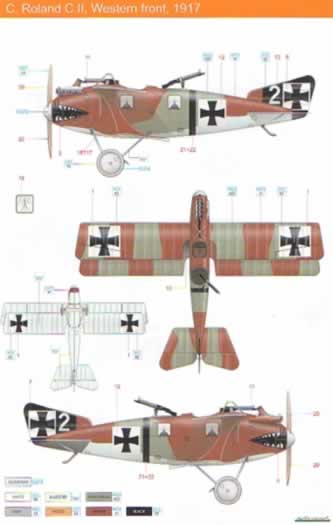292b-sn-C-2701-16-600px.png)
The Roland C.II was a German reconnaissance plane from the first World War. Compared to other 2-seat-planes of the time, it had a much lower drag. It also featured a bigger strength per weight than others, but was slow and expensive. The C.II was powered by a Mercedes D III with 160 hp, allowing a top speed of 165 km/h and a ceiling of 4000 m. The aircraft was introduced in 1916. Pilots reported that it had a good performance but wasn't easy to handle. Because of it's speed it could only be intercepted from above.
 In Combat
In CombatDue to it's complicated production and small number it reached the front very late, but was very needed for the creation of the new Kampfgeschwader's [KAGOHL (Kampfgeschwader der Obersten Heeresleitung= Fighting Squad of the High Command)], which used a number of very outdated aircraft.
The plane was very stable but was because of it's poor forward and downward visibility uneasy to land. It reached the Western Front in March 1916 and could deal with the allied fighters of the time due to it's good aerodynamics. Famous pilots where Hermann Köhl, a successful squad leader and Eduard von Schleich, who later crossed the Atlantic. He painted his "Walfisch" with Eyes and a Jaw so it looked even more like a whale. In 1917 the C.II's where slowly withdrawn from the front.
General DataCrew: 2
Length: 7.52 m/ 24 ft 8 in
Wingspan: 10.33 m/ 33 ft 20.5 in
Height: 2,89 m/ 9 ft 6 in
Wing Area: 26.00 m² / 300.85 ft²
Empty Weight: 789 kg/ 1,736 Ib
Loaded Weight: 1309 kg/ 2880 Ib
Powerplant: 1x Mercedes D III water-cooled in-line, 160 hp/ 120 kw
PerformanceMaximum speed: 165 km/h (102 mph) at sea level
Range: 825 km (511 miles)
Service Ceiling: 4000m
Rate of Climb: 7 minutes to 1000m (3280 ft)
 Armament
ArmamentGuns: 7.92 mm parabellum machine gun, forward firing 7.92 mm Spandau Machine Gun
Bombs: four 12.5 kg bombs under the fuselage



 Blueprints
Blueprints

 Detail Shots
Detail ShotsFuselage:

Destroyed:

Wings Interior:

 Sources:
Sources:The English & German Wikipedia.
 Author
Topic: Roland C.II 'Walfisch' (Read 6579 times)
Author
Topic: Roland C.II 'Walfisch' (Read 6579 times)


